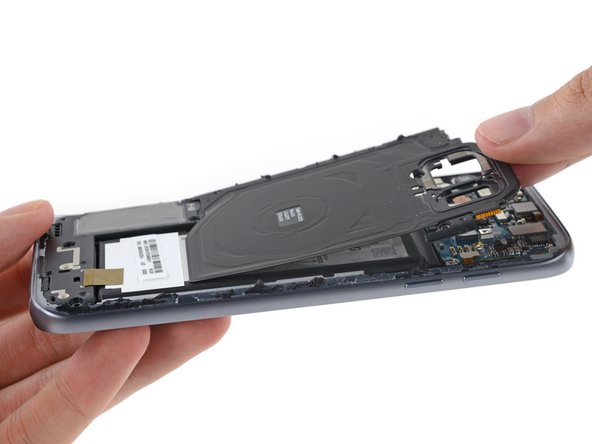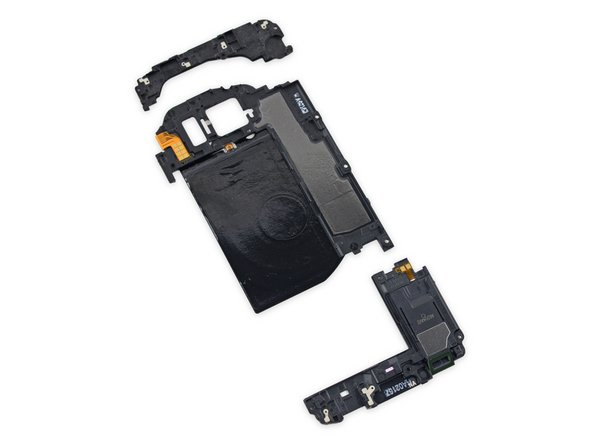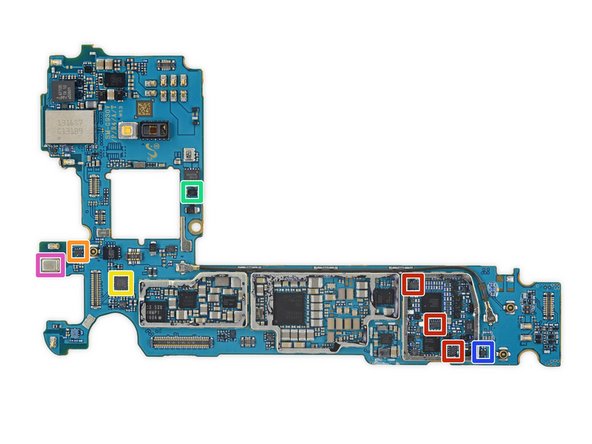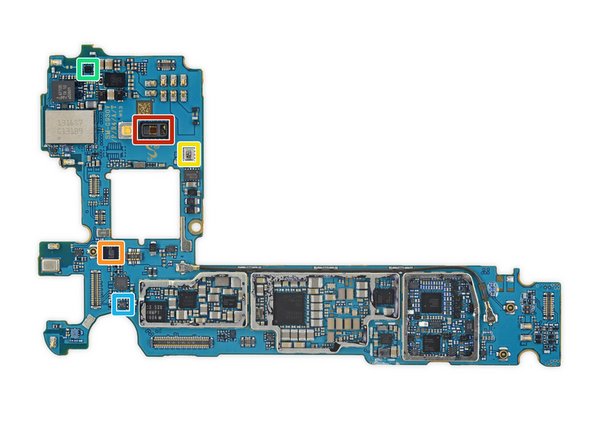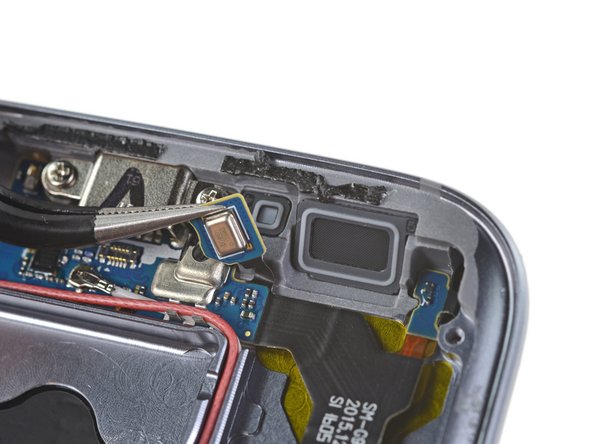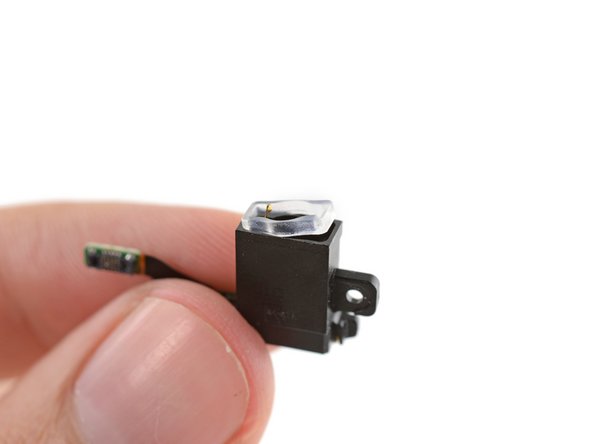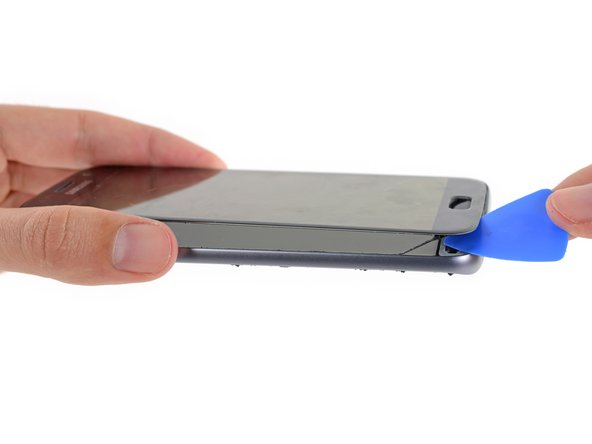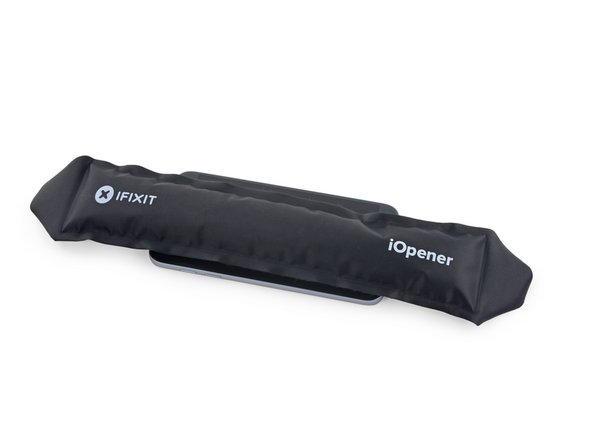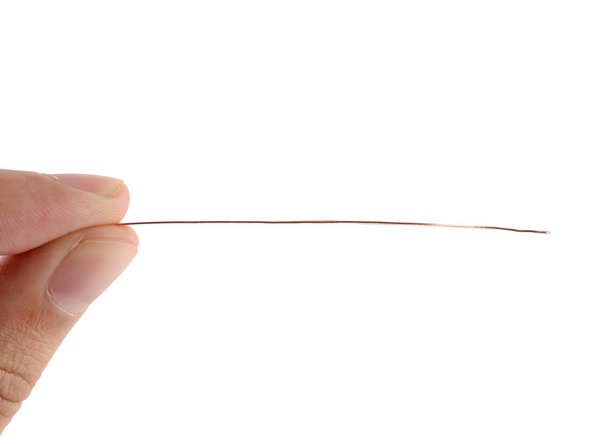Samsung Galaxy S7 Teardown
Duration: 45 minutes
Steps: 23 Steps
This phone might have been opened a few times before, but we're excited to dig into the mysterious thermal spreader ourselves. Will the new tech in the S7 live up to the hype? Only a teardown will reveal the truth. Keep up with the latest repair updates and get an exclusive look behind the scenes of our teardown process by following us on Instagram, Twitter, and Facebook.
Step 1
Since the S7 is a bit of a mystery and hasn't made its debut online yet, we're in the realm of educated guesses here!
- While the legend says the number 7 has some magic, who knows what kind of magic the S7 brings? If we were just throwing guesses into the wind, here’s what you’d find inside: a 5.1-inch Super AMOLED display rocking 2560 × 1440 resolution (that's a crisp 576 ppi), a Qualcomm Snapdragon 820 processor teamed up with 4 GB of RAM and an Adreno 530 GPU for smooth sailing, a 12-megapixel rear camera with dual pixel autofocus plus 4K video recording, and a 5-megapixel selfie cam to snap your best angles. Storage-wise, you get 32 or 64 GB built-in, plus room to grow with a MicroSD card up to 200 GB. It’s also waterproof with an IP68 rating, and runs on Android 6.0 Marshmallow. Need a hand with the repair? You can always schedule a repair.
Step 2
The S7 trims about a millimeter off the S6's length and width, while adding nearly a full extra millimeter in thickness. Still, at just 7.9 mm thick, it stays nice and slim—and even comes with a smaller camera bump to keep things sleek.
- Looking at the S7, it’s clear that it’s a step up from the S6. The back panel now curves smoothly around the sides, making it a lot more comfortable to hold. Nice touch, right?
- The S6's glass-on-glue design didn’t exactly impress us in the repairability department. We gave it a 4 out of 10—and let’s just say, we weren't exactly jumping for joy. But hey, the S7 might just turn out to be a pleasant surprise. Fingers crossed!
- Wait, which one’s the S7 again? No worries, just flip them over and take a quick look—no harm in double-checking.
Step 3
A bunch of the latest flagship phones like the Nexus 6P, LG G5, and OnePlus 2 rock the Type-C connector, but most of them aren’t showing off everything this handy port can actually do.
- Samsung stuck with the classic micro USB port, skipping out on the new USB Type-C trend.
- They tossed in a USB adapter to make switching to a new phone a breeze—almost as if they're nudging you toward an upgrade before your current phone waves the white flag. Odd move.
- At the moment, Samsung seems pretty confident that the older, more universal connection works just fine.
- Maybe it's because all those free Gear VR headsets would feel a little left out if the phones suddenly switched ports.
Step 4
- Since there are no visible screws on the outside, the only thing holding this Galaxy together is a healthy dose of glue. Time to get out our trusty twin-suction-cup iSclack and get to work—perfect for lifting those glass panels on the S7. Once you've got a little lift on the rear glass, gently slide in an opening pick and carefully slice through the adhesive. It’s a familiar routine, just a tad stickier this time around. Luckily, a hot iOpener makes quick work of softening stubborn adhesive, so keep it handy. If you need help along the way, you can always schedule a repair.
Step 5
- Where last year we encountered sticky white adhesive, now we're dealing with gooey black stuff. Maybe it was reformulated for waterproofing, or perhaps it just matches the new look—either way, it's a change. Trying to remove the back cover hasn't revealed much—just a smooth surface for the glass to cling to. Luckily, part of that surface includes screws to help you along the way. If you need help, you can always schedule a repair.
Step 6
- That smooth surface isn't just for looks—it hides some handy components, like the S7's antennas...
- ...and it’s where the speaker is tucked away...
- ...and, of course, MY axe.
- Wouldn’t it be great to have a battery you could swap out yourself, or at least an easy-to-reach connector? That’s wishful thinking these days. Samsung’s repairability game has changed a lot since the Galaxy S4 era.
Step 7
Last year's Galaxy flagship featured a single midframe with several parts stuck on tightly, so this new separation is a refreshing and welcome twist in our opinion!
- Let's get cozy with our components and take a good look at the individual parts, including that nifty wireless charging coil.
- All these modular bits connect to the motherboard through tiny spring contacts, making removal and replacement a breeze—once you tackle the glue and glass, that is!
Step 8
Unfortunately, as highlighted by this crucial warning label, the S7's battery isn't a fan of puppies. Keep them at bay while you work!
That's a notable upgrade compared to the Galaxy S6's 2550 mAh battery, and it even outshines the bigger iPhone 6s Plus's 2750 mAh powerhouse.
- Samsung took some heat for downsizing the battery on last year's S6, but they listened and upped the game with a robust 3000 mAh battery in the S7.
- While this battery upgrade lets you enjoy more app and gaming time, it's snugly fixed in place, which means getting it out can be a bit of a challenge.
- If it wasn’t made for easy access, then it probably wasn’t meant for easy repair or replacement. Bummer!
Step 9
- We're working our way toward the motherboard now. First up, we carefully remove the 5-megapixel front-facing camera. It's a bit of a journey, but nothing we can't handle.
- The S7 camera upgrade isn't exactly mind-blowing—if you were hoping for a selfie revolution, sorry! The only change here is a shiny new ƒ/1.7 aperture, so it's more about the little things than a giant leap forward.
- With the front camera safely out of the way, we gently lift the motherboard and uncover a familiar daughterboard connector underneath. We're almost there!
Step 10
But here’s the cool part: the sensor in the S7 features Dual Pixel autofocus technology, meaning every single pixel is ready to quickly lock focus using phase detection. Pretty slick, right?
- While the S6 boasts a 16-megapixel rear camera, the S7 takes a different path with a 12-megapixel/4K rear camera. It’s a bit of a surprise! But don't worry; there’s more to this story.
- Taking a closer look at the camera assembly reveals some interesting details:
- These pixels are now measuring in at 1.4 µm, which is a nice 25% bump from last year's model. So, even though there are fewer pixels, you can expect those late-night shots to shine brighter and clearer when you compare them side by side.
- Sony IMX260 12 MP image sensor (likely)
- Renesas OIS driver
- STMicroelectronics L2G2IS 2-axis MEMS gyroscope
- Winbond W25Q32FWXGIG 32 Mb flash memory
Step 11
- Time to lift those EMI shields and see what treasures are hiding underneath. Here’s what’s tucked away on the board:
- SK Hynix H9KNNNCTUMU-BRNMH 4 GB LPDDR4 memory stacked right on top of the Qualcomm MSM8996 Snapdragon 820
- Samsung KLUBG4G1CE-B0B1 32 GB MLC universal flash storage 2.0 for all your speedy data needs
- DSP Group DBMD4 audio and voice processor
- Qualcomm WCD9335 audio codec
- Maxim Integrated MAX98506BEWV audio amplifier
- Maxim Integrated MAX77854EWZ power management with built-in li-ion battery charger
- ON Semiconductor load switch
Step 12
- And here's a few extra goodies:
- Avago AFEM-9040: a multiband multimode module that brings the magic.
- Murata FAJ15: a front-end module to keep you powered up.
- Qorvo QM78064: your high band RF fusion module ally.
- Qorvo QM63001A: a diversity receive module for top-notch reception.
- TDK D5287: a trusty antenna switch module to keep things connected.
- TDK D5275: another antenna switch module because more is merrier.
- Qorvo TQF6260: a power amplifier duplexer ready to boost your device.
Step 13
- Here's a quick rundown of some key components to keep in mind: the Samsung 1316S7 Wi-Fi Module, probably rocking a Broadcom BCM4359 WiFi/Bluetooth chip, is a crucial part for wireless connectivity. The NXP Semiconductor 67T05 (PN67T) NFC controller handles tap-and-go magic, while the IDT P9221 wireless power receiver (likely an update of the P9220) keeps your device juiced wirelessly. The STMicroelectronics LSM6DS3 is your always-on 6-Axis IMU sensor, giving motion detection a serious boost. The Qualcomm PM8996 PMIC manages power like a boss, and the Qualcomm QFE3100 envelope tracker fine-tunes RF signals for clear communication. Lastly, the Qualcomm WTR4905 and WTR3925 RF transceivers keep your device talking wirelessly without a hitch. Need hands-on help? You can always schedule a repair with Salvation Repair to get everything sorted out.
Step 14
- Let's dive into IC identification, part 2! Here are some processors and drivers you might encounter:
- 1. Samsung camera processor (could be the one!)
- 2. Zinitix ZF115N haptic driver - feel that feedback!
- 3. Samsung S2MPB02 power management - keeping things powered up!
- 4. Qualcomm PM8004 power management - another power pal!
- 5. Maxim Integrated MAX77838EWO power management - this one's a real champ!
- 6. NXP Semiconductor NCX2200 comparator - making comparisons easier!
- 7. Toshiba TC7SBD385FU bus switch - switching things up!
Step 15
- Let’s dive into IC identification, part 3:
- Check out the NXP Semiconductor BGU8103—this little guy is the GPS/GLONASS/Galileo/BeiDou low noise amplifier, keeping your location signals crisp.
- Next, we have the NXP Semiconductor BGS8M2, which handles LTE low noise amplification.
- Also on the list is the NXP Semiconductor BGS8H2, another LTE low noise amplifier doing its part.
- Don’t forget the NXP Semiconductor BGS8L2, yet another LTE low noise amplifier in the lineup.
- Switching gears to Infineon, the BGSX22GN10 is a DPDT RF antenna switch, managing your antenna connections smoothly.
- Then there’s the Infineon BGS12SN6 RF switch, keeping RF signals in check.
- And finally, the Infineon BGS12PL6 RF switch wraps up this batch of important components.
Step 16
- IC identification, pt. 4:
- Spot the Infineon RF switch—this little guy handles radio signals like a pro.
- Find the Infineon antenna tuning switch, perfect for keeping those connections sharp.
- Check out the RDA Microelectronics RDA6213N FM radio receiver, your gadget’s backstage pass to FM tunes.
- Look for the ON Semiconductor FPF2495B—this chip keeps your device protected from voltage and current surprises.
- Track down the Diodes Incorporated AP7346D-3318FS6-7, a versatile dual 3.3V & 1.8V LDO regulator that keeps things running steady.
- Locate the Diodes Incorporated AP7340D-18FS4-7, the 1.8V LDO regulator that’s all about smooth power delivery.
- Last but not least, spot the Knowles MEMS microphone—the tiny powerhouse behind crystal-clear audio.
Step 17
- IC identification, pt. 5 (sensors):
- Get to know the Maxim Integrated MAX86902 – it's your go-to heart rate sensor with integrated pulse oximetry and UV sensing, likely to be hanging out in your device.
- Meet the STMicroelectronics LSM6DS3, your trusty 3-axis accelerometer and gyroscope that keeps everything balanced and moving.
- Say hello to the Bosch Sensortec BMP280, the pressure sensor that’s always on the lookout for atmospheric changes.
- Don't forget about the AKM Semiconductor AK09911, the 3-axis electronic compass that makes sure you never lose your way.
- Last but not least, we have the ABLIC, Inc. (formerly Seiko Instruments) S-5712CCDL1-I4T1U, the Hall sensor, quietly working behind the scenes.
Step 18
- Now it's time to tackle the S7's swappable headphone jack.
- Samsung went all-in with the IP68 rating on this flagship—think high-level water and dust defense.
- Rubber seals are guarding the lower microphone and speaker, so the inside stays safe from sneaky spills and dust.
- And check out that little rubber seal! Adorable, but also tough.
Ever wondered if a certain fruit company's recent waterproofing efforts might be behind your device's issues? Well, let's take a closer look and see if that juicy rumor holds water. With a steady hand and a friendly approach, we’ll walk through the steps to diagnose and fix your device—because sometimes, a little insight is all you need to juice up your repair game. If you need help along the way, you can always schedule a repair.
Step 19
- Just like the model before it, the S7's soft button cables are cleverly wrapped around the frame behind the display.
- No worries though, we bring back our trusty iOpener to gently soften up that stubborn adhesive.
- While we’re at it, we grab a reliable opening pick and carefully tackle the not-so-fun job of prying open the OLED screen.
- These cables are sandwiched in a way that makes swapping out the daughterboard (including the charging port) almost impossible without removing the OLED display first.
Tools Used
Step 20
Remember that fake "midframe" made of antennas? Well, the S7 took it up a notch by tucking its midframe deeper inside and sticking the display right onto it, instead of just screwing the display assembly to a midframe.
- Lift up those stubborn soft button LED cables and you'll finally set the daughterboard free.
- Just to keep it real, this tangled setup makes swapping out the display, digitizer, USB port, microphone, and soft button LEDs a total pain.
- If your charging port needs a swap, and you're not a wizard with microsoldering, your options are: say goodbye to those soft button LEDs or go all in and replace the display too.
- The S7 is tough against water, but these repairs will give you a run for your money if something goes wrong that isn’t related to moisture.
Step 21
- Time to get to know the stars of the show! Here's a lineup of the fabulous little chips and components you'll be working with:
- First up, we've got the ABOV Semiconductor MC80F1504M, a nifty 8-Bit microcontroller with 8 Kb of flash memory. It's like the brain of the operation!
- Next, say hello to the Qualcomm QFE2550 antenna tuner, making sure your signals stay sharp and clear.
- We've also got the Infineon antenna tuning switch, helping to keep everything tuned in just right.
- Don't forget the Knowles MEMS microphone, capturing all those sweet sounds.
- And last but not least, the ABLIC, Inc. (formerly Seiko Instruments) S-5712CCDL1-I4T1U Hall sensor, adding some extra magic to the mix!
Step 22
Think of it as a tiny, sleek heat pipe—a slender copper tube with less than half a gram of material and under half a millimeter thick. It’s a small but mighty component that helps keep things cool behind the scenes.
- Okay, here we are: let's take a look at the much-hyped 'liquid cooling' system in the S7.
- Turns out, it's just a little copper pipe.
- It might not be as groundbreaking as Samsung makes it sound, but hey, most heat pipes use liquid to move heat around anyway.
- For the S7, we think the pipe pushes the heat into the phone's metal midframe, which then spreads it out to the sides—or maybe right into your hands.
- Heat pipes aren't new to smartphones, but the fact that we see more of them means phone processors are getting faster—and hotter—every year.
Step 23
- Samsung Galaxy S7 Repairability Score: 3 out of 10 (where 10 is the easiest to fix).
- Many of the parts are modular, meaning they can be swapped out without much hassle.
- Unlike the S6 Edge, the battery comes out without having to remove the motherboard—but keep in mind, sticky adhesive and a glued-on rear panel make the whole process trickier than it needs to be.
- To replace the USB port, you'll need to remove the display (which might not survive the journey).
- Both front and back glass are prone to cracks, and the rear glass is held on with a powerful adhesive, so getting into the device could be a bit of a challenge.
- Replacing the glass without damaging the display is likely a mission impossible.
















